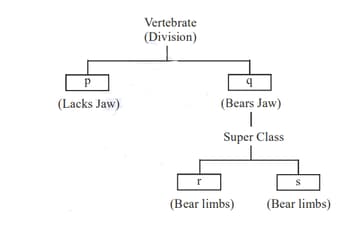Which of the following are features of chordate?
Notochord is present.
CNS is dorsal, hollow and single.
Pharynx perforated by gill slits.
Heart is ventral.
A post-anal is present.
Important Questions on Animal Kingdom
Name the classes of Tetrapoda that exhibit the following characters:
| Column (A) | Column (B) |
| Acrodont | Thecodont |
| pairs cranial nerves | pairs cranial nerves |
| Cold-blooded | Warm-blooded |
| Amphicoelous vertebrae | Amphiplatyan vertebrae |
Observe the following simplified scheme and choose the correct option that matches with the letters given in the boxes.

Which of the following statements are true for the phylum-Chordata?
(a) In Urochordata, notochord extends from head to tail, and it is present throughout their life.
(b) In Vertebrata, the notochord is present during the embryonic period only.
(c) Central nervous system is dorsal and hollow.
(d) Chordata is divided into 3 subphyla: Hemichordata, Tunicata, and Cephalochordata.
Statement I: Sternum appeared for the first time in amphibians.
Statement II: Snakes have pairs of cranial nerves.
The correct option among the following is
Identify the wrongly matched Scientific and common name:
| Scientific name | Common name |
| a) Bungarus | Krait |
| b) Exocoetus | Flying fish |
| c) Trygon | Electric ray |
| d) Carcharodon | Dogfish shark |
| e) Myxine | Hagfish |
a) Chondrichthyes have gill slits covered by operculum and Osteichthyes have gill slits without operculum
b) Chondrichthyes have a swim bladder and Osteichthyes do not have a swim bladder
c) Chondrichthyes contain placoid scales and Osteichthyes contain cycloid scales
d) Chondrichthyes contain terminal mouth and Osteichthyes contain ventral mouth
Which of the key adaptations helped evolutionary success of Reptiles on land?
A Warm-bloodedness
B. Pulmonary respiration and dry scaly skin
C. Internal fertilisation
D. Amniotic & Cleidoic eggs
Statement Chordates have a tail extending posterior to the anus. It contains skeletal elements and muscles but lacks coelom and visceral organs.
Reason In aquatic organisms, it acts as a balancing organ.

